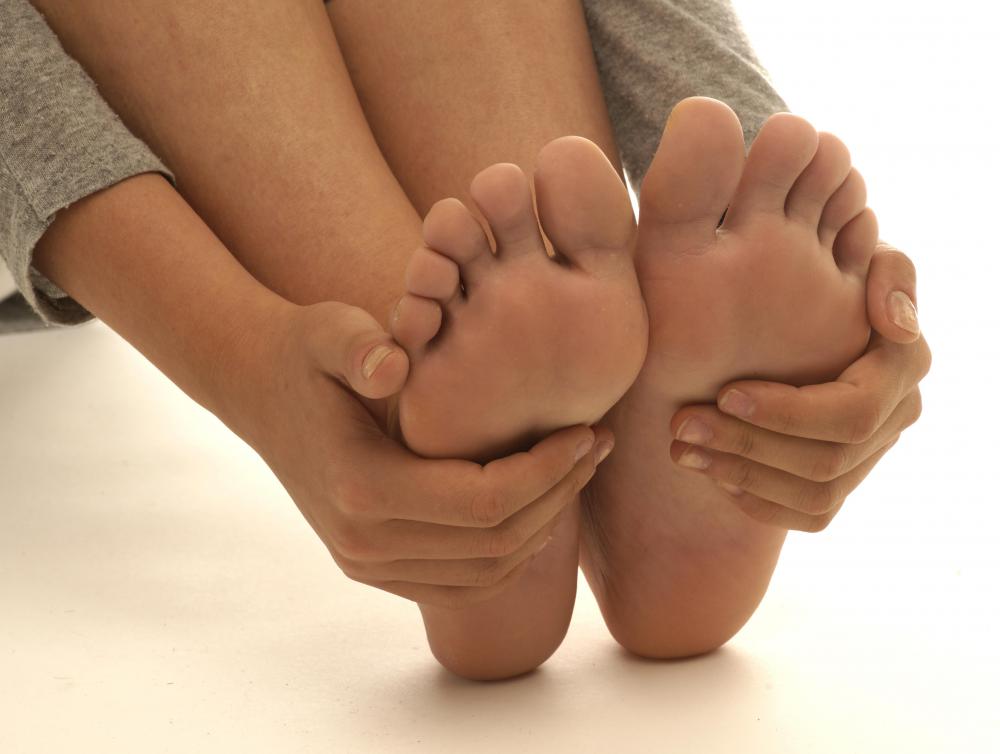At WiseGEEK, we're committed to delivering accurate, trustworthy information. Our expert-authored content is rigorously fact-checked and sourced from credible authorities. Discover how we uphold the highest standards in providing you with reliable knowledge.
What Is Anterior Tibial Tendinitis?
A tendon is a tough, fibrous cord of tissue that connects muscles to bones. Anterior tibial tendinitis, also known as tibialis anterior tendinopathy, is a condition where the area that connects the leg muscles, specifically the tibilais anterior muscle, to the foot bones on the anterior or front of the shin sustains an injury. This can occur when the anterior tibialis muscle is overstretched or stressed.
The tibialis anterior muscle is responsible for allowing the foot to flex or move the toes up towards the leg. Activities that may place an excessive amount of strain to the tibialis anterior tendon include walking, especially on uneven or hilly surfaces or activities requiring kicking motions or intricate footwork patterns with frequent stoppages or bursts of movements. Firm or unyielding direct contact to this tendon such as securing shoe laces too tightly or prolonged kneeling can aggravate the tendon and cause anterior tibial tendinitis.

Symptoms of this condition include tenderness in the tendon area and pain experienced with movement, especially pointing the toes upwards. This discomfort may also be accompanied with swelling, especially if the tendon irritation is caused by an injury. Pain may be worse at night and stiffness may occur after attempting to move ankle and foot.
Anterior tibial tendinitis symptoms can appear suddenly when the area is injured. With prolonged overuse or strain, pain and tenderness may appear gradually or with specific ankle and foot movements. The initial inflammation or sudden pain accompanied with swelling caused by this condition, referred to as the acute phase, should be treated with an immediate stoppage of aggravating activities and a method termed “RICE”: rest, ice, compression and elevation.

Once the inflammation process has decreased, a comprehensive stretching and strengthening program is necessary to return to normal pain free movement. Stretching is essential to assure the anterior tibialis tendon has enough flexibility to function properly. Strengthening exercises of the foot and ankle provides support and can help prevent further injuries. Balance training and specialized exercises specific to the sport or activity is also beneficial in avoiding further damage or pain associated with anterior tibial tendinitis.

Full recovery from anterior tibial tendinitis depends on the nature and severity of the injury to the tendon. Often it takes several weeks to several months to return to peak athletic performance. Once the tendon is healed it is important to continue a stretching and strengthening program to the area to avoid further problems with the area.
AS FEATURED ON:
AS FEATURED ON:















Discussion Comments
Acetaminophen is not going to give you the anti-inflammatory properties you need. Take an NSAID (e.g., ibuprofen/Motrin). I usually take 800mg of ibuprofen two or three times daily for the inflammation/pain.
I'm having reconstruction surgery for my tibialis anterior muscle next week. I've had tendinitis for months and the muscle is too damaged to heal on its own.
Has anyone else had this surgery?
@alisha-- Try naproxen, that usually works for me.
I had anterior and posterior tibial tendinitis numerous times in college. You really need to rest it out. Rest, ice and elevation for at least several days should take care of it.
Once the pain is gone, you can do some shin and calve exercises and stretching to strengthen the muscle. But keep in mind that if you over-use any muscle, it will become inflamed and painful, so the key is moderation.
Which type of pain reliever is best for tendinitis?
The front part of both of my legs started to ache last week, my doctor said that it's anterior tibialis tendinitis. I've been told to rest and take pain relievers but I forgot to ask which type of pain reliever.
I've been taking acetaminophen but it's not helping. I have pain and stiffness all day even though I'm resting most of the time.
Post your comments